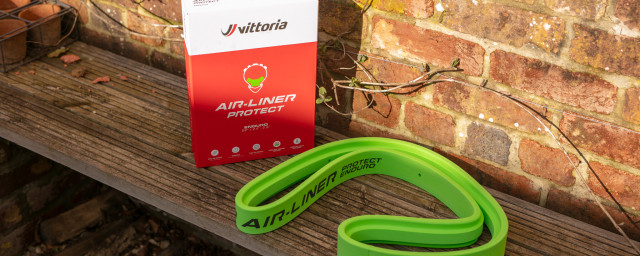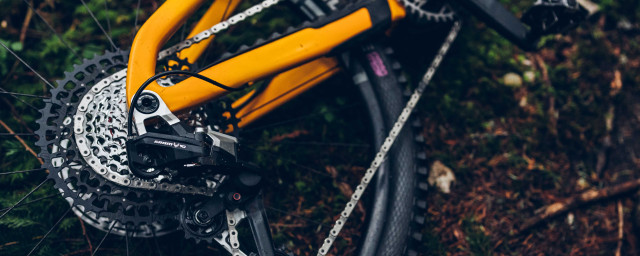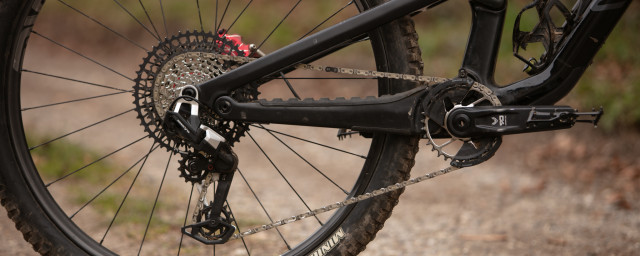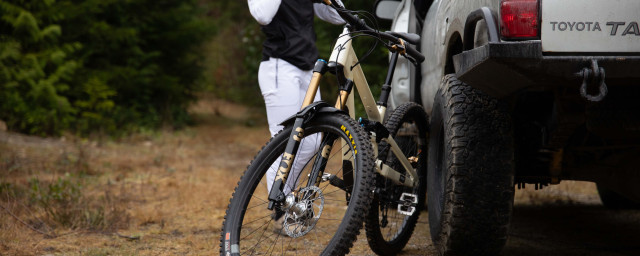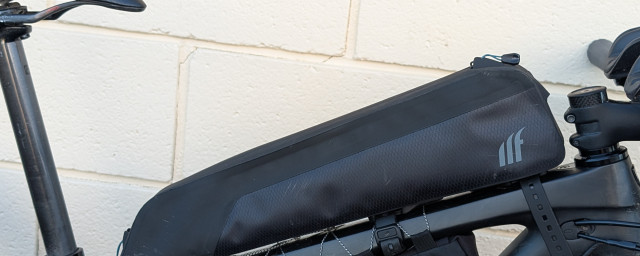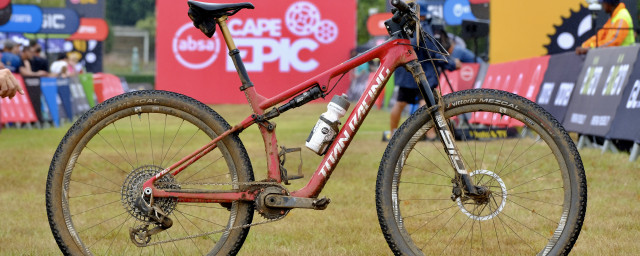Merida eOne-Sixty 875 first ride review

The eOne-Sixty’s update is far more than a new lick of paint. The brand has taken the very solid foundation laid by its One-Sixty enduro bike and has applied that to its new e-MTB platform while meticulously crafting it to better suit the extra weight of equipping a bike with a motor and battery. Once again, we went over to the Forest of Dean to get some time on the bike ahead of its launch.
- Tips for beginner mountain bikers
- Merida One-Twenty 700 first ride review
- Merida One-Sixty FR 600 first ride review
Merida eOne-Sixty 875 - Technical details
With Merida’s new eOne-Sixty platform, the brand is effectively offering two bikes: one featuring a carbon frame and the other being built from alloy. However, it’s more than just build material deep as the carbon or CF bikes get a lighter weight and lesser capacity non-removable 600Wh battery and generally, it’s built to offer a full 85Nm of power while being as light as possible.
The Lite or alloy framed bike is sorted with a weightier 750Wh removable battery. Merida says that this bike hits the mark in terms of value but although there’s a big ol’ hole in the downtube for battery removal, it maintains stiffness and durability. That said, Merida states that the Lite is built for range.
As the eOne-Sixty Lite is the bike I spent some time aboard, I’ll let the news piece do all of the talking for Merida's new eOne-Sixty CF and eOne-Forty models.
The eOne-Sixty Lite takes a lot of the design cues that we saw on the brand’s One-Sixty pedal-powered bike but tailors them to better suit the demands of e-MTB. That notably includes the P-Flex flex stay technology. By building the rear end with a flex stay, Merida has been able to ditch any bearings and hardware that come as part of a Horst link and reduce weight as well as the maintenance requirement. Even though this is a big heavy e-bike, the brand stresses that the employment of a flex stay affects the longevity of the frame.
The eOne-Sixty also takes advantage of the brand’s FAST kinematic that was introduced on the One-Sixty but as you would expect, it’s been tuned for the e-MTB. As always, however, it's a size-specific kinematic with a progression that matches each frame size, catering to different body weights and riding styles, with help from the brand’s Agilometer sizing concept.
Agilometer is another thing that’s been transferred from the analogue bike that uses the bike’s adjustable dropper post, low standover height and low stack to allow riders to choose a bike’s size for their desired ride character. So instead of being limited by their height, a potential customer can choose a longer bike for stability, or a shorter frame for agility while still being able to fit over it.
This bike also gets a similar geometry update but it’s not a simple copy-and-paste job as Merida recognises that an e-MTB gets a lot of stability from its extra weight, being lumbered with a battery and motor. So while the new bike’s geometry has received a monumental step forward, the brand has dialled back some changes in a move to boost manoeuvrability on this heavier bike.
To put that into numbers, there’s a 64.4-degree head angle, a 78.4-degree seat tube, a 446mm chainstay, and a 459mm reach on a Mid frame. There is a flip-chip on the frame, however. This has been included to retain the geometry when switching rear wheel sizes, rather than adjust the geometry. As standard, the eOne-Sixty gets a 650b rear wheel to further boost agility and to open up loads of room over the rear of the bike for when trails get steep.
Where the bike makes more of a change is in how the shock is mounted and the hardware it uses. It goes without saying but the shock is mounted sideways in the frame, and this hasn’t been done just to look cool but it’s this way to provide space in the front triangle for a water bottle and a range extender. The yoke is also a lot smaller than before to increase stiffness and the e-bike's greater loads that are transmitted to the shock. This then means that the eOne-Sixty can run a coil shock.
The bike also gets a boost in suspension travel. Despite being called the eOne-Sixty, it’s draped with 174mm of bounce at the rear and 170mm up front. Only when paired with a 29-inch wheel at the rear does it live up to its name, featuring 160mm of suspension.
This bike gets tyre clearance for up to 2.6in tyres, there’s chainstay protection as well as a redesigned battery cover. The bike gets Merida’s trail mount that allows for the fitting of tools and spares, and of course, there are all the Merida mod-cons, including the multi-tool hidden under the saddle and the Allen keys found on the rear axle handle.
Merida has kitted all eOne-Sixty models with Shimano’s EP801 which kicks out 85Nm of torque but the brand offers a 360Wh range extender, offering an 80 percent capacity increase against the previous bikes.
Merida eOne-Sixty 875 - Componentry
The eOne-Sixty 875 is Merida's highest-end alloy e-MTB and it's specced rather competitively. It's not full bling but its componentry is more than up to the job. All in all, this build will set you back £6,000.
Up front, its 170mm of suspension is sorted with thanks to a RockShox ZEB Select, and the rear 174mm of squish is damped by a RockShox Super Deluxe shock.
Shifting is handled by Shimano's XT drivetrain and its four-piston brakes come from the very same range. The eOne-Sixty 875 rolls on own brand wheels which are shod with the new-classic enduro tyre choice, the Maxxis Assegai at the front with a Minion DHR II at the rear. Merida has been good with its tyres too, opting for a EXO+ casing and MaxxGrip compound at the front paired with a Double Down casing at the rear with a MaxxTerra rubber.
Merida then sorts a lot of the finishing kit with its own bar and its most recent, and most clever adjustable dropper post that allows up to 230mm of travel but it can be adjusted down to help riders of almost any size fit over the bike properly.
Merida eOne-Sixty 875 - Ride impressions
I spent a bit of time aboard Merida’s eOne-Sixty 875 over at the Forest of Dean where I sampled it through tracks ranging from the smooth and groomed to the natural and more technical trails. Admittedly, all of these trails were atrociously wet but, in hindsight, the lack of grip and confidence in the trail proved an ample but challenging testing ground for a bike of this calibre.
As a bike that’s equipped with all of the forward-thinking details, philosophies and technologies that Merida has worked very hard to establish in its current bikes the eOne-Sixty initially feels very familiar. Its seat angle is steep and its reach is comparatively long but its effective top tube is short, so pedalling this bike about is comfortable, as it keeps the rider upright. However, where the seat tube is ever so slightly slacker and the head tube is a bit steeper than its leg-powered counterpart, weight is distributed more evenly over the bike, which boosts grip when climbing.
Where I would usually choose the same frame size on an e-bike as I would a regular bike, with the knowledge that the eOne-Sixty is as long as what we’ve not come to expect from the brand and that Merida acknowledges that e-MTBs achieve a lot of stability through their weight, I picked a Mid-size frame which was a great move, if I do say so myself. When pedalling the bike about, it was certainly smaller than I’m used to but the bike feels very balanced in all scenarios. And by no means is the reach on the Mid short for its size but this is where Merida’s Agilometer sizing makes so much sense.
Going for a smaller-than-usual size rewarded me with a blend of mind-blowing stability with an appreciable level of manoeuvrability. The eOne-Sixty is a bike that’s empowered by its weight and when the 174mm of suspension travel is thrown into the mix the eOne-Sixty is one confidence-inspiring bit of machinery. As with many e-bikes, the extra weight gets the bike’s suspension working overtime which in turn makes for a bike that’s completely point and shoot, and super forgiving. It encouraged me to find the chunkiest lines I could just to get an inkling of where its limits lie – I'm yet to even get close.
It’s almost a different kind of fun because the eOne-Sixty is so glued to the ground that it’s incredibly committed to where it’s pointed, taming chunk and gathering high levels of momentum. However, the suspension isn’t without a useful and clear level of midstroke support which makes that 174mm of squish approachable and more versatile than the bike lets off. In the corners, the rear end summons up impressive grip thanks to its supple start to mid-stroke but, when pushing through compressions, the bike doesn’t wallow and the platform reacts positively to pumping. This is where the eOne-Sixty does a fairly good job of masking its mass as it remains somewhat reactive to input.
The eOne-Sixty is far from a featherweight though but it’s a bike that uses the fact completely to its advantage making it capable of serious speed without ever getting nervous or twitchy. It holds its line tenaciously and given how wet the trails I sampled the bike over were, I was able to ride the bike with almost as much confidence as I would in the dry.
Notably, the bike’s sheer stability translates identically when airborne. I’m not one to confidently hit large kickers but when working the bike over rollers and lips, it does encourage a bit of hooliganism and when the wheels are off of the ground – well, I’ve never felt so confident in the air. That’s another pro of its weight figure as even when in the air, the eOne-Sixty refuses to be shifted offline.
Merida eOne-Sixty 875 - Early verdict
Where the bike is full of commitment, downsizing by choosing a Mid-sized frame was massively rewarding. As I’ve said, I was still able to take full advantage of the bike’s stability but the shorter frame size made it a lot more manageable than expected everywhere. The bike is still a lumbering beast but picking the smaller size made corners easier to navigate and claws back a hint of briskness to the eOne-Sixty’s ride. This is an aspect of the ride where the eOne-Sixty's slighter steeper head angle pays back. On any other person-powered bike, I'd be reaching for my pitchfork after hearing that it's got a steeper headtube but it has resulted in a quicker and faster handling front end, which compensates for the bike's weight.
However, the weight isn’t without its downsides. The bike isn’t as dynamic or responsive as lighter bikes which is the compromise for its all-out conviction when rolling through technical terrain. And, while the mullet wheel size adds a bit of pep to its character, the eOne-Sixty does require a good bit of muscle when slithering around consecutive corners. It’s a trade-off though, a compromise, and if you’re all for monster trucking through things that usually require considered line choice, this is a bike for you, although it can feel a little bit like using a sledgehammer to tap in a picture hook in some areas. If liveliness and dynamism are what you’re after, the eOne-Sixty CF does a great job. Where it comes to a real problem is when manhandling the bike around. I’ve only walked it up a hill and swung it around before dropping into a section to have a picture taken but the kilos play a part here, so lifting the bike into a car or a van will become an effort that may be best avoided if you suffer from back problems or prior injuries.
The new eOne-Sixty 875 is one heavy chap but where that may be seen as a downside on paper, it has loads of travel and that’s where the real charm lies. It’s not a bike that’s trying to be something it’s not – rather, it’s an absolute bruiser that takes full advantage of its heft to get its mass of suspension working hard, rewarding with loads of grip and inspiring tonnes of confidence. The brand has done a stellar job in compensating for its mass in small geometry tweaks that result in a manageable ride. And where I’ve not taken full advantage of the benefits of Agilometer before, it’s great to see the brand’s concepts proving to be a vital aspect of its design.









